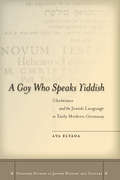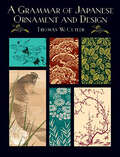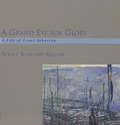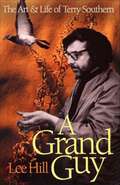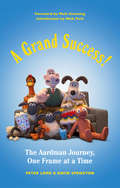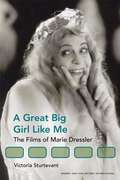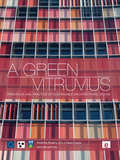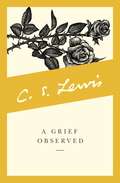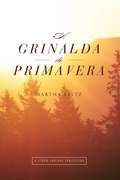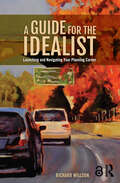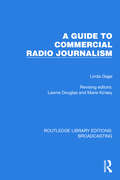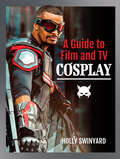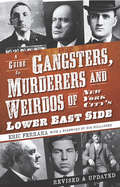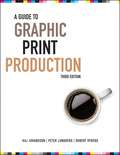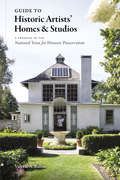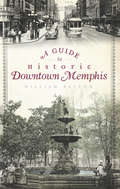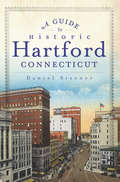- Table View
- List View
A Goy Who Speaks Yiddish: Christians and the Jewish Language in Early Modern Germany
by Aya ElyadaThis book explores the unique phenomenon of Christian engagement with Yiddish language and literature from the beginning of the sixteenth century to the late eighteenth century. By exploring the motivations for Christian interest in Yiddish, and the differing ways in which Yiddish was discussed and treated in Christian texts,A Goy Who Speaks Yiddishaddresses a wide array of issues, most notably Christian Hebraism, Protestant theology, early modern Yiddish culture, and the social and cultural history of language in early modern Europe. Elyada's analysis of a wide range of philological and theological works, as well as textbooks, dictionaries, ethnographical writings, and translations, demonstrates that Christian Yiddishism had implications beyond its purely linguistic and philological dimensions. Indeed, Christian texts on Yiddish reveal not only the ways in which Christians perceived and defined Jews and Judaism, but also, in a contrasting vein, how they viewed their own language, religion, and culture.
A Grammar of Japanese Ornament and Design
by Thomas W. CutlerThe lovely images in this rare collection comprise one of the most comprehensive surveys of mid-19th-century Japanese art and ornamentation. Included are graceful details from landscapes, floral motifs, abstracts, illustratons of sea life, and other subjects-ideal for use in a host of art and craft projects. Over 300 figures on 65 plates.
A Grand Eye for Glory: A Life of Franz Johnston
by Roger Burford MasonWinner of the 1999 International Gallery of Superb Printing Gold Award for Superb Craftsmanship in Production Franz Johnston is the missing man of Canadian painting. The most prolific and financially successful of the original Group of Seven, Johnston’s paintings were among the most sought after in Canada in the years between the mid-1920s and his death in 1949. They appear in the collections of dozens of discriminating private collectors, and in institutions such as the National Gallery, the Art Gallery of Ontario, the McMichael Canadian Collection, and the Canadian War Museum. As well, his work once hung, in thousands of well-loved reproductions, on the walls of ordinary people’s homes the length and breadth of the country. And yet, for all his distinguished success, Johnston is no more than a footnote in the many histories of the Group of Seven, and is rarely mentioned in the context of the general development of art in Canada in the twentieth century. Johnston was born and raised in Toronto, worked with J.E.H. MacDonald, Fred Varley, Arthur Lismer, and Franklin Carmichael at Grip, the famous commercial art studio in Toronto, and served with distinction as an official war artist in the last years of the First World War. He subsequently taught at the art schools in Winnipeg and Toronto (he was the principal of the Winnipeg Art School and Gallery for four years in the early 1920s) before opening his own art school on the shores of Georgian Bay. When the Group of Seven held its first, seminal exhibition at the Art Museum of Toronto in May 1920, Johnston exhibited and sold more paintings than any of the others. In this, the first biography of Franz Johnston, the author seeks to provide a guide to the life, work, and times of this unjustly neglected, but influential figure in Canadian art and culture. Beautifully illustrated with sixteen four-colour reproductions of Johnston’s best paintings, and rare black-and-white photographs from a family collection and other sources.
A Grand Guy: The Art & Life of Terry Southern
by Lee Hill"When they're no longer surprised or astonished or engaged by what you say, the ball game is over. If they find it repulsive, or outlandish, or disgusting, that's all right, or if they love it, that's all right, but if they just shrug it off, it's time to retire."-- Terry SouthernA Grand GuyHe was the hipster's hipster, the perfect icon of cool. A small-town Texan who disdained his "good ol' boy" roots, he bopped with the Beats, hobnobbed with Sartre and Camus, and called William Faulkner friend. He was considered one of the most creative and original players in the Paris Review Quality Lit Game, yet his greatest literary success was a semi pornographic pulp novel. For decades, the crowd he ran with was composed of the most famous creative artists of the day. He wrote Dr. Strangelove with Stanley Kubrick, Easy Rider with Peter Fonda and Dennis Hopper, and worked on Saturday Night Live with a younger, louder breed of sacred cow torpedoers. He's a face in the crowd on the cover of Sgt. Pepper's Lonely Hearts Club Band (the guy in the sunglasses). Wherever the cultural action was, he was there, the life of every party -- Paris in the '50s, London in the swinging '60s, Greenwich Village, and Big Bad Hollywood. Brilliant, dynamic, irrepressible, he enjoyed remarkable success and then squandered it with almost superhuman excess. There was, and ever will be, only one Terry Southern.In a biography as vibrant and colorful as the life it celebrates, Lee Hill masterfully explores the high and low times of the unique, incomparable Terry Southern, one of the most genuine talents of this or any other age. Illuminating, exhilarating, and sobering, it is an intimate portrait of an unequaled satirist and satyrist whose appetite for life was enormous -- and whose aim was sure and true as he took shots at consumerism, America's repressive political culture, upper-class amorality, and middle-class banality. But more than simply the story of one man, here is a wide-screen, Technicolor view of a century in the throes of profound cultural change -- frorn the first chilly blasts of the Cold War and McCarthyism to the Vietnam era and the Reagan years; from Miles and Kerouac to the Beatles, the Stones, and beyond. And always at the center of the whirlwind was Terry Southern -- outrageous, unpredictable, charming, erudite, and eternally cool; a brazen innovator and unappreciated genius; and most of all, A Grand Guy.
A Grand Success!: The Aardman Journey, One Frame at a Time
by David Sproxton Peter LordThe creators of Chicken Run and the Wallace & Gromit series share the inside story of their Oscar award-winning animation company.Aardman Animations was founded in 1972 by Peter Lord and David Sproxton. Joined by animator Nick Park in 1985, Aardman pioneered a quirky, lovable style of stop-motion animation and brought to life a string of unforgettable movies and television shows, including the highest-grossing stop-animated film of all time, Chicken Run.With A Grand Success!, Lord, Sproxton, and Park tell the 45-year history of Aardman. From their first short films, made on a lark on their kitchen table, to advertisements and music videos, A Grand Success! recounts the adventures and challenges of developing their own unique style, growing their business, working with famous actors, and conquering Hollywood, all while animating at 24 painstaking moves per second.
A Graphic Design Student's Guide to Freelance: Practice Makes Perfect
by Ben HannamA complete guide to freelance graphic design—created specifically for design students Why wait until you graduate? Freelancing is a great way to jumpstart your career in graphic design. It lets you apply what you've been learning in school, close the gaps in your education with real-world experience, enhance your portfolio—and make a little money at the same time. A Graphic Design Student's Guide to Freelance: Practice Makes Perfect covers everything you need to know to begin successfully freelancing as a designer, including how to set up your business, deal with legal and financial issues, find clients, and work with them effectively. This full-color guide is divided into sections that correspond to your particular skill level as a student—beginner, intermediate, or advanced. These sections give you specific tasks and goals to help your freelance design work go smoothly as you progress from your very first professional job to gain experience with a range of projects and clients and prepare to move into a full-time graphic design career once you complete your studies. Complete with sample forms available online (invoices, a proof approval form, job jacket, and more) and 175 color images, including samples of paid work created by students, A Graphic Design Student's Guide to Freelance: Practice Makes Perfect will help you navigate the world of freelance design with confidence. Inside this book, you will learn to: Write a business plan Purchase key equipment Set rates and draw up contracts Find and manage clients Create and show concepts Market your company Expand your business Develop your portfolio And more
A Great Big Girl Like Me: The Films of Marie Dressler
by Victoria SturtevantIn the first book-length study of Marie Dressler, MGM's most profitable movie star in the early 1930s, Victoria Sturtevant analyzes Dressler's use of her body to challenge Hollywood's standards for leading ladies. At five feet seven inches tall and two hundred pounds, Dressler often played ugly ducklings, old maids, doting mothers, and imperious dowagers. However, her body, her fearless physicality, and her athletic slapstick routines commanded the screen. Sturtevant interprets the meanings of Dressler's body by looking at her vaudeville career, her transgressive representation of an "unruly" yet sexual body in Emma and Christopher Bean, ideas of the body politic in the films Politics and Prosperity, and Dressler as a mythic body in Min and Bill and Tugboat Annie.
A Green Vitruvius: Principles and Practice of Sustainable Architectural Design
by Vivienne Brophy J Owen Lewis2000 years ago the roman architect Marcus Vitruvius Pollio wrote the ten books on architecture establishing the concept of the pattern book offering design principles and solutions that is still referred to in every architect's education. A Green Vitruvius is intended as a green pattern book for today. Now fully updated, this well established textbook provides advice suitable for undergraduate and post graduate students on the integration of sustainable practice into the design and construction process, the issues to be considered, the strategies to be adopted, the elements of green design and design evaluation within the process. Classic design elegance is found in the holistic clear solution.
A Greene Country Towne: Philadelphia’s Ecology in the Cultural Imagination
by Alan C. Braddock Laura Turner IgoeAn unconventional history of Philadelphia that operates at the threshold of cultural and environmental studies, A Greene Country Towne expands the meaning of community beyond people to encompass nonhuman beings, things, and forces.By examining a diverse range of cultural acts and material objects created in Philadelphia—from Native American artifacts, early stoves, and literary works to public parks, photographs, and paintings—through the lens of new materialism, the essays in A Greene Country Towne ask us to consider an urban environmental history in which humans are not the only protagonists. This collection reimagines the city as a system of constantly evolving constituents and agencies that have interacted over time, a system powerfully captured by Philadelphia artists, writers, architects, and planners since the seventeenth century. In addition to the editors, contributors to this volume are Maria Farland, Nate Gabriel, Andrea L. M. Hansen, Scott Hicks, Michael Dean Mackintosh, Amy E. Menzer, Stephen Nepa, John Ott, Sue Ann Prince, and Mary I. Unger.
A Greene Country Towne: Philadelphia’s Ecology in the Cultural Imagination
by Alan C. Braddock Laura Turner IgoeAn unconventional history of Philadelphia that operates at the threshold of cultural and environmental studies, A Greene Country Towne expands the meaning of community beyond people to encompass nonhuman beings, things, and forces.By examining a diverse range of cultural acts and material objects created in Philadelphia—from Native American artifacts, early stoves, and literary works to public parks, photographs, and paintings—through the lens of new materialism, the essays in A Greene Country Towne ask us to consider an urban environmental history in which humans are not the only protagonists. This collection reimagines the city as a system of constantly evolving constituents and agencies that have interacted over time, a system powerfully captured by Philadelphia artists, writers, architects, and planners since the seventeenth century. In addition to the editors, contributors to this volume are Maria Farland, Nate Gabriel, Andrea L. M. Hansen, Scott Hicks, Michael Dean Mackintosh, Amy E. Menzer, Stephen Nepa, John Ott, Sue Ann Prince, and Mary I. Unger.
A Grief Observed (Faber Paperbacks Ser.)
by C. S. LewisWritten after his wife's tragic death as a way of surviving the "mad midnight moment," A Grief Observed is C.S. Lewis's honest reflection on the fundamental issues of life, death, and faith in the midst of loss. This work contains his concise, genuine reflections on that period: "Nothing will shake a man -- or at any rate a man like me -- out of his merely verbal thinking and his merely notional beliefs. He has to be knocked silly before he comes to his senses. Only torture will bring out the truth. Only under torture does he discover it himself." This is a beautiful and unflinchingly homest record of how even a stalwart believer can lose all sense of meaning in the universe, and how he can gradually regain his bearings.
A Grinalda de Primavera
by Martha KeltzSondra, de 18 anos, ou “Sunny”, se formou recentemente no ensino médio. Depois que sua mãe solteira faleceu, Sunny assumiu a tutela legal de sua meia-irmã Amanda, ou “Mandy”, que tem oito anos de idade. A história começa em junho, quando as garotas se mudam de Nova York para uma pequena cidade montanhosa no oeste de Maryland. Elas receberam duas propriedades que pertenciam ao pai de Mandy, que nunca conheceram. As coisas tornam-se complicadas para Sunny quando sua irmãzinha deseja continuar seu treinamento de balé. A criança é uma dançarina excepcionalmente talentosa e uma pequena superestrela natural e carismática, enquanto Sunny é uma garota quieta, estudiosa e trabalhadora, que ainda não tem certeza sobre a direção que sua vida tomará. Com a assistência capaz de muitos novos amigos que as irmãs conheceram na pequena cidade, além de seus bons amigos em Nova York, Sunny coloca de lado seus próprios interesses e objetivos para gerenciar a carreira de Mandy. No entanto, ela consola o conforto - e realiza seu destino final - através de excursões sossegadas e solitárias para uma pequena casa na floresta chamada de “Cabana”, uma das propriedades dadas às duas meninas. Aqui ela descobre as maravilhas naturais da floresta circundante e o número incompreensível de estrelas no céu profundo noturno. O duplo mistério de A Grinalda de Primavera é revelado perto do final da história. Uma parte do mistério faz sentido para Sunny, enquanto ela se surpreende com o segundo significado mais pessoal.
A Guide for the Idealist: Launching and Navigating Your Planning Career
by Richard WillsonA Guide for the Idealist is a must for young professionals seeking to put their idealism to work. Speaking to urban and regional planners and those in related fields, the book provides tools for the reader to make good choices, practice effectively, and find meaning in planning work. Built around concepts of idealism and realism, the book takes on the gap between the expectations and the constraints of practice. How to make an impact? How to decide when to compromise and when to fight for a core value? The book advises on career "launching" issues: doubt, decision-making, assessing types of work and work settings, and career planning. Then it explains principled adaptability as professional style. Subsequent chapters address early-practice issues: being right, avoiding wrong, navigating managers, organizations and teams, working with mentors, and understanding the career journey. Underpinning these dimensions is a call for planners to reflect on what they are doing as they are doing it. The advice provided is based on the experience of a planning professor who has also practiced planning throughout his career. The book includes personal anecdotes from the author and other planners about how they launched and managed their careers, and discussion/reflection questions for the reader to consider.
A Guide for the Idealist: Launching and Navigating Your Planning Career
by Richard WillsonA Guide for the Idealist is a must for young professionals seeking to put their idealism to work. Speaking to urban and regional planners and those in related fields, the book provides tools for the reader to make good choices, practice effectively, and find meaning in planning work. Built around concepts of idealism and realism, the book takes on the gap between the expectations and the constraints of practice. How to make an impact? How to decide when to compromise and when to fight for a core value? The book advises on career "launching" issues: doubt, decision-making, assessing types of work and work settings, and career planning. Then it explains principled adaptability as professional style. Subsequent chapters address early-practice issues: being right, avoiding wrong, navigating managers, organizations and teams, working with mentors, and understanding the career journey. Underpinning these dimensions is a call for planners to reflect on what they are doing as they are doing it. The advice provided is based on the experience of a planning professor who has also practiced planning throughout his career. The book includes personal anecdotes from the author and other planners about how they launched and managed their careers, and discussion/reflection questions for the reader to consider.
A Guide to (Short) Documentary Filmmaking: Creating Artful Short Documentary Films
by Jamie MeltzerUsing examples and hard-earned experiences from the Author's courses and lectures at the esteemed MFA in Documentary Film Program at Stanford University, A Guide to (Short) Documentary Filmmaking: Creating Artful Short Documentary Films explores what is unique about the short-form documentary and guides the reader through the process – from ideation to completion and distribution.This accessible and practical textbook guides readers through the steps of creating powerful and artful documentaries. Interviews with filmmakers and case studies of innovative and successful recent documentary shorts are included throughout to provide experienced insights and complement the chapters on Research, Pre-production, Production, Editing, and Distribution.The first and most definitive of its kind, this is the only resource to explore the short documentary as a distinct art form. It will therefore be essential for all students and professionals involved in producing this medium.
A Guide to Commercial Radio Journalism (Routledge Library Editions: Broadcasting #2)
by Linda GageA Guide to Commercial Radio Journalism (1999) covers every aspect of the profession, from journalistic practice to media law, and gives detailed instruction on the techniques of editing and using equipment and on the basic skills of writing, reporting and producing. There is also a whole chapter dedicated to advice on court reporting.
A Guide to Eighteenth-Century Art
by Linda WalshA Guide to Eighteenth-Century Art offers an introductory overview of the art, artists, and artistic movements of this exuberant period in European art, and the social, economic, philosophical, and political debates that helped shape them. Covers both artistic developments and critical approaches to the period by leading contemporary scholars Uses an innovative framework to emphasize the roles of tradition, modernity, and hierarchy in the production of artistic works of the period Reveals the practical issues connected with the production, sale, public and private display of art of the period Assesses eighteenth-century art’s contribution to what we now refer to as ‘modernity’ Includes numerous illustrations, and is accompanied by online resources examining art produced outside Europe and its relationship with the West, along with other useful resources
A Guide to Film and TV Cosplay
by Holly Swinyard"This guide offers background information about how contemporary cosplay has developed as well as nuts and bolts practical information for those wishing to start or continue participation in the hobby." — BooklistHave you ever wanted to escape into a comic book and become your favourite superhero? Or run away into the world of Disney princesses? Well, who says you can’t? Maybe it’s time you get your cosplay on! Cosplay is a hobby that is sweeping the globe, you can see it at comic cons, book launches, movie screenings and even on popular TV shows such as The Big Bang Theory and Community. A mix of exciting craft skills, heady escapism and passion for pop culture, it’s easy to see why cosplay has become so popular with people no matter who they are, because now they can be anyone they want, and so can you. But how, why and where could you have a go at starting out in the wonderful world of cosplay? With a little bit of help from this handy, dandy guide to cosplay, you can get stuck in. Learn about the history of the hobby (it’s been around longer than you’d think!), get your head around picking you’re first costume, find out how about all the amazing skills people are using to make these costumes, and perhaps even try a few yourself. Who knows, you might be rocking our as Captain Marvel or Flynn Rider at the next big comic con! (And don’t worry, there’s a guide to comic con in here too.)
A Guide to Gangsters, Murderers and Weirdos of New York City's Lower East Side
by Eric Ferrara Rob HollanderNew York's Lower East Side is the birthplace of everything from organized crime to anarchist movements. In the nineteenth century, an influx of struggling immigrants seeking opportunity met the harsh realities of industrialization. Poverty and squalor fueled a vicious battle for power and political clout. Local historian Eric Ferrara reveals the wicked history of America's most infamous neighborhood, where the abounding graffiti is a testament to the soul and spirit of the slum.
A Guide to Graphic Print Production
by Kaj Johansson Peter Lundberg Robert RybergThe fully revised edition of the most comprehensive and up-to-date reference on print production A II graphic designers and illustrators must be familiar with the steps involved in preparing their work for publication. Now completely revised to reflect the latest technology and trends, A Guide to Graphic Print Production, Third Edition is the complete guide to the entire process of print production, from the early stages of conception and planning, to the technical stages of manufacturing and off-press processing. Structured around the graphic print production flow, essential material is included for all aspects of the process including coverage of computers, color management, layouts, digital images, image editing, prepress, paper, printing, finishing and binding, legal issues, environmental issues, and more.
A Guide to Historic Artists' Home and Studios
by Valerie BalintFrom the desert vistas of Georgia O'Keeffe's New Mexico ranch to Jackson Pollock and Lee Krasner's Hamptons cottage, step into the homes and studios of illustrious American artists and witness creativity in the making. Celebrating the twentieth anniversary of the Historic Artists' Homes and Studios program of the National Trust for Historic Preservation, this is the first guidebook to the forty-four site museums in the network, located across all regions of the United States and all open to the public. The guide conveys each artist's visual legacy and sets each site in the context of its architecture and landscape, which often were designed by the artists themselves.Through portraits, artwork, and site photos, discover the powerful influence of place on American greats such as Andrew Wyeth, Grant Wood, Winslow Homer, and Donald Judd as well as lesser-known but equally creative figures who made important contributions to cultural history—photographer Alice Austen and muralist Clementine Hunter among them.
A Guide to Historic Downtown Memphis (History & Guide)
by William PattonNeed a practical, useful guide to downtown Memphis's historic streets, buildings and neighborhoods? Look no further than A Guide to Historic Downtown Memphis. From Beale Street to the Bluffs, this guidebook covers all the essentials that no explorer of the River City should be without. Each chapter provides a map for a different section of downtown Memphis, guiding readers on a journey to the historic reaches of this modern city. The destinations may vary from classic theatres to barbeque joints, from churches to saloons, but the road always leads to another fascinating Memphis discovery. Perfect for out-of-town visitors or Memphians who need a helpful guide to showcase the attractions that make their hometown one of a kind.
A Guide to Historic Hartford, Connecticut (History & Guide)
by Daniel SternerHartford, Connecticut, was settled as an agrarian society with fertile fields and abundant crops at the confluence of the Connecticut and Little (later Park) Rivers by Reverend Thomas Hooker and his Puritan congregation. Navigation on the rivers quickly established the city as a center for commerce. Author Daniel Sterner delves into the history of Hartford with tours from Bushnell Park to Asylum Hill and through Frog Hollow. Discover the many people, places and events that have shaped the capital of the Constitution State.
A Guide to Historic New Haven, Connecticut (History & Guide)
by Colin M. CaplanAuthor Colin M. Caplan is a native of New Haven and an active member of the local architecture and preservation community. He founded Magrisso Forte, a design-based consulting firm dedicated to fostering awareness of New Haven's cultural resources. This book details eighteen walks and nine guided driving/biking tours around the city.
A Guide to Historic Staunton, Virginia (History & Guide)
by Edmund D. PotterUnlike many small towns in the South that were occupied by the Union army, beautiful Staunton, Virginia, emerged from the Civil War largely unscathed. Join historianEdmund Potter on a walking tour through the many architectural gems and notable buildings of downtownStaunton's five National Historic Districts. From thepicturesque Wharf Area to the birthplace of Woodrow Wilson to the town's many historically African American businesses, A Guide to Historic Staunton offers visitors and residents alike a deeper appreciation of their remarkable surroundings.
